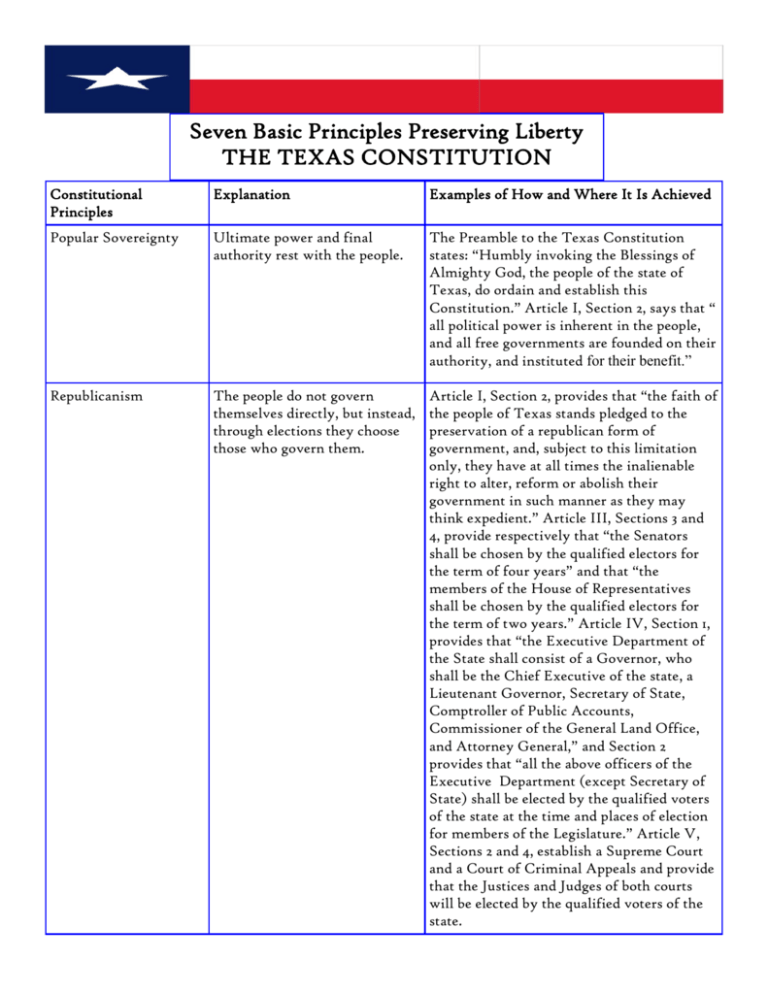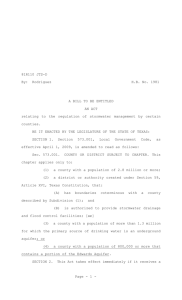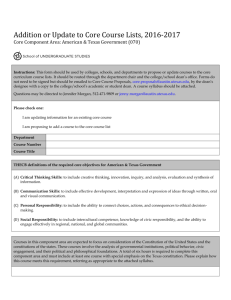
Seven Basic Principles Preserving Liberty
THE TEXAS CONSTITUTION
Constitutional
Principles
Explanation
Examples of How and Where It Is Achieved
Popular Sovereignty
Ultimate power and final
authority rest with the people.
The Preamble to the Texas Constitution
states: “Humbly invoking the Blessings of
Almighty God, the people of the state of
Texas, do ordain and establish this
Constitution.” Article I, Section 2, says that “
all political power is inherent in the people,
and all free governments are founded on their
authority, and instituted for their benefit.”
Republicanism
The people do not govern
themselves directly, but instead,
through elections they choose
those who govern them.
Article I, Section 2, provides that “the faith of
the people of Texas stands pledged to the
preservation of a republican form of
government, and, subject to this limitation
only, they have at all times the inalienable
right to alter, reform or abolish their
government in such manner as they may
think expedient.” Article III, Sections 3 and
4, provide respectively that “the Senators
shall be chosen by the qualified electors for
the term of four years” and that “the
members of the House of Representatives
shall be chosen by the qualified electors for
the term of two years.” Article IV, Section 1,
provides that “the Executive Department of
the State shall consist of a Governor, who
shall be the Chief Executive of the state, a
Lieutenant Governor, Secretary of State,
Comptroller of Public Accounts,
Commissioner of the General Land Office,
and Attorney General,” and Section 2
provides that “all the above officers of the
Executive Department (except Secretary of
State) shall be elected by the qualified voters
of the state at the time and places of election
for members of the Legislature.” Article V,
Sections 2 and 4, establish a Supreme Court
and a Court of Criminal Appeals and provide
that the Justices and Judges of both courts
will be elected by the qualified voters of the
state.
Seven Basic Principles Preserving Liberty
THE TEXAS CONSTITUTION
Constitutional
Principles
Explanation
Examples of How and Where It Is Achieved
Federalism
Texas is a state within the
federal system of government of
the United States where power
is divided between the national
government and the
governments of the individual
states. The U.S,. Constitution
lists the powers of the national
government as well as certain
powers denied to the states, and
its Tenth Amendment provides
that powers not delegated to the
national government and not
denied to the states are reserved
to the states or to the people.
Article I, Section 1 states that “Texas is a free
and independent state, subject only to the
Constitution of the United States, and the
maintenance of our free institutions and the
perpetuity of the Union depend upon the
preservation of the right of local selfgovernment, unimpaired to all the states.”
Article XVI, Section 12, provides that “no
member of Congress, nor person holding or
exercising any office of profit or trust, under
the United States, or either of them, or under
any foreign power, shall be eligible as a
member of the Legislature, or hold or exercise
any office of profit or trust under this State.”
Various articles discuss at length such
subjects as education, railroads, and local
government units such as counties,
municipalities,
and soil and water conservation districts. The
U. S. Constitution contains no mention
whatsoever of any of these matters, thus
indicating that in our federal system they are
subjects largely left to the jurisdiction of the
individual states.
Separation of Powers
Power within the state’s
government is divided among
three separate branches:
Legislative, Executive, and
Judicial.
Unlike the U. S. Constitution which does not
specifically call for “separation of powers”
within the national government, Article II,
Section 1, of the Texas Constitution
specifically provides that “the powers of the
Government of the State of Texas shall be
divided into three distinct departments, each
of which shall be confided to a separate body
of magistracy, to wit: those which are
Legislative to one; those which are Executive
to another, and those which are Judicial to
another; and no person, or collection of
persons, being of one of these departments,
shall exercise any power properly attached to
either of the others, except in the instances
herein expressly permitted.”
Seven Basic Principles Preserving Liberty
THE TEXAS CONSTITUTION
Constitutional
Principles
Explanation
Examples of How and Where It Is Achieved
Checks and Balances
Each of the three branches
of Texas government has
certain controls (checks)
over the other two.
Article XV grants the Texas House of
Representatives the power to impeach any of the
executive officers of the state such as the Governor
or the Lieutenant Governor as well as judges of
Texas District Courts and higher courts. The same
Article grants the Texas Senate the power to try any
individual whom the House impeaches. Article IV
states that “every bill which shall have passed both
houses of the Legislature shall be presented to the
Governor for his approval.” In addition, Article IV
authorizes the Governor to veto one or more items
of an appropriations bill while approving the rest of
such a bill. Article III, Section 33 provides that “all
bills for raising revenue shall originate in the House
of Representatives, but the Senate may amend or
reject them as other bills.” Article VIII, Section 6,
provides that “no money shall be drawn from the
Treasury but in pursuance of specific appropriations
made by law.” Article III, Section 40, provides that
only the Governor can call a “special session” of the
Legislature and furthermore that in a special session
the Legislature can only consider subjects designated
by the Governor. Like the U. S. Constitution, the
Texas Constitution does not specifically provide for
“judicial review.” Nevertheless, the Texas Supreme
Court in particular plays an important role in
interpreting laws passed by the Texas Legislature
and even on rare occasions declaring them to be in
violation of the Texas Constitution. The Court can
do the same for actions of the Governor or for
actions of other executive agencies of Texas
government. For example, in the Edgewood public
school finance case in 1989the Court brought about
major changes in the financing of public education.
In 1994, to cite another example, the Texas Supreme
Court overturned a Texas Education Agency ruling
that home schools were illegal and upheld the right
of parents to educate their children.
Seven Basic Principles Preserving Liberty
THE TEXAS CONSTITUTION
Constitutional
Principles
Explanation
Examples of How and Where It Is Achieved
Limited Government
The power of Texas government
is limited by the Texas
Constitution, the U.S.
Constitution, laws made by the
U.S. Congress in pursuance of
the U.S. Constitution, and by
treaties made by the U.S. with
other nations of the world.
The Governor’s power is limited by the fact
that he does not hire and thus cannot give
orders to or fire most of the other really
important officers in the executive branch.
The Legislature is limited by the fact that it
meets in regular session biennially in odd
numbered years only and only for 140 days.
The judicial branch is limited by the fact that
Texas has not one but two highest state
courts: the Supreme Court for civil cases only
and the Court of Criminal Appeals for
criminal cases only. The powers of all three
branches are limited not only by the Texas
Bill of Rights and other parts of the Texas
Constitution but also by most of the U. S.
Bill of Rights and by the limitations imposed
on all of the states by Article I, Section 10 of
the U. S. Constitution. Finally, the Texas
Legislature is limited in how much money it
can spend by Article III, Section 49a which
requires that before the Legislature can pass
any appropriations bill, the Comptroller of
Public Accounts must certify that he expects
revenue will be available to pay for the
proposed expenditure.
Seven Basic Principles Preserving Liberty
THE TEXAS CONSTITUTION
Constitutional
Principles
Explanation
Examples of How and Where It Is Achieved
Individual Rights
Personal freedoms, personal
protections, and equality under
the law are guaranteed by the
U.S. Constitution, the U.S. Bill
of Rights, laws of the U.S., the
Texas Constitution, and the
Texas Bill of Rights.
Article I, Section 10 of the U. S. Constitution,
for example, provides that no state shall pass
any ex post facto law or bill of attainder or
any law impairing the obligation of contracts.
Like the U. S. Bill of Rights, Article I of the
Texas Constitution, which is the Texas Bill
of Rights, provides for freedom of speech,
press, religion, assembly, petition, etc.
The Texas Bill of Rights also provides for the
right to keep and bear arms as well as the
same rights of the accused in criminal cases
that are found in the U. S. Bill of Rights.
Section 3a of the Texas Bill of Rights also
provides that “equality under the law shall
not be denied or abridged because of sex, race,
color, creed, or national origin.” The Texas
Bill of Rights also provides for some rights
not found in the U. S. Bill of Rights. For
example, Section 18 provides that “no person
shall ever be imprisoned for debt,” and a
lengthy Section 30 outlines the rights of
crime victims.
All rights reserved. Permission is granted for these materials to be reproduced for classroom
use only. No part of these materials may be reproduced in any other form or for any other
purpose without the written consent of Law Related Education, State Bar of Texas.
For additional information on the LRE Program, please go to www.texaslre.org








